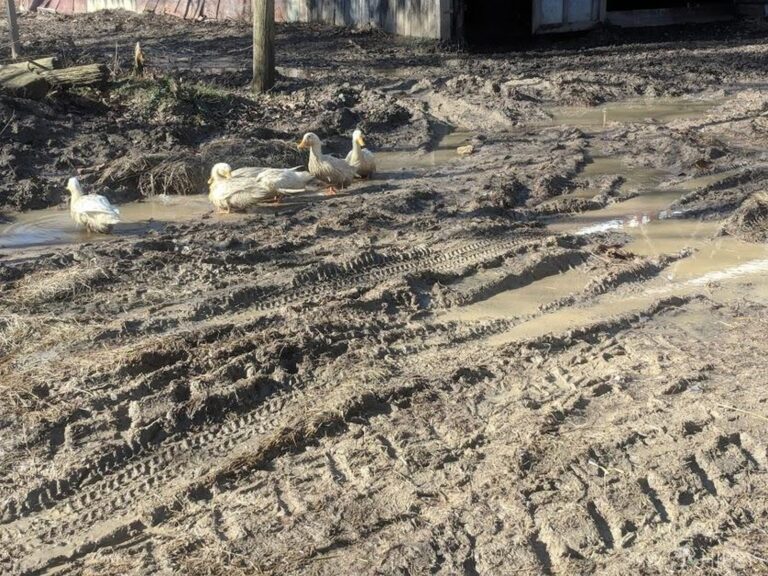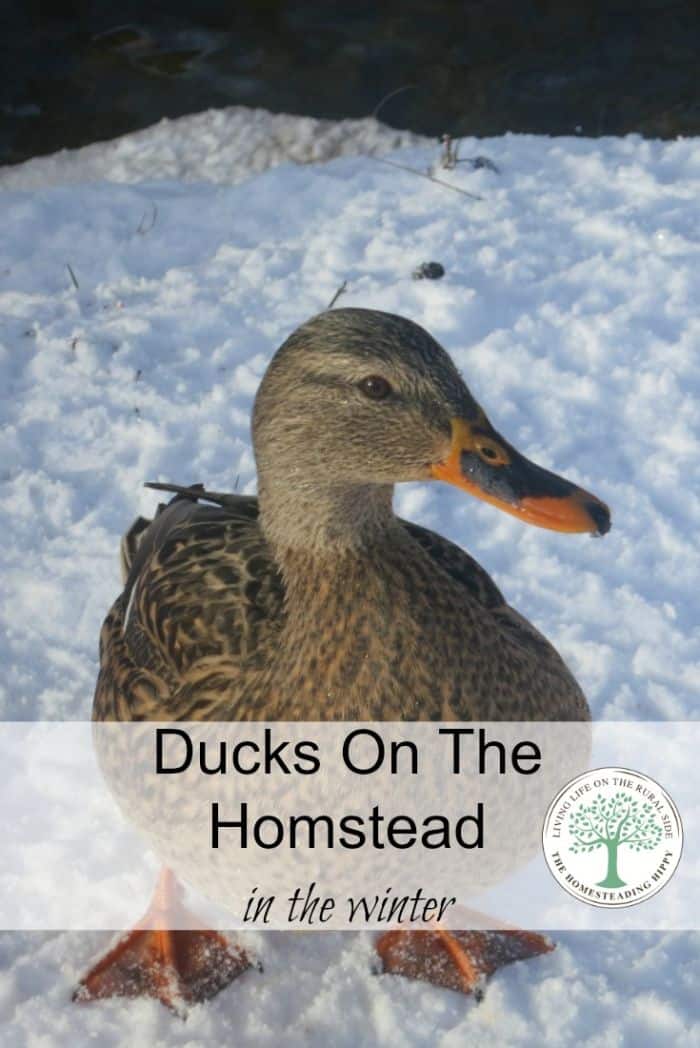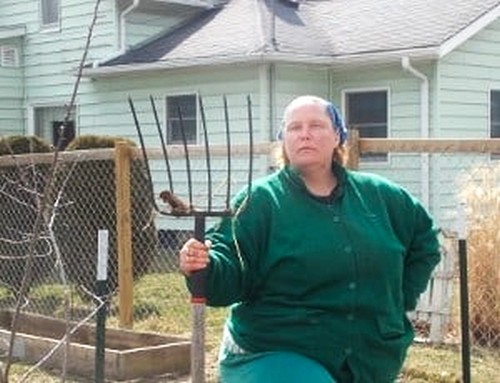Raising ducks in the winter when it’s cold, snowy, or icy isn’t hard. All it takes is a few extra steps of care and some planning ahead, and your ducks will be just as happy as ever. They can be great egg producers all year long.

We love our ducks on this homestead. They have a quirky personality that makes them so much fun to watch.
When their tails wriggle or they waddle around, quacking to each other, it makes for better entertainment than any TV show to me. Ducks are low maintenance, they give us fresh eggs, and they’re fun…what more could you ask for?
Do Ducks Get Cold in the Winter?
Many people believe that ducks are immune to cold weather because they spend so much time in water. However, this is not the case.
While ducks are well-adapted to colder temperatures, they can still experience discomfort when the weather gets too frigid. In fact, when the temperature drops too low, ducks will actually go into a light torpor, or a trance-like state, in order to conserve energy.
While it may seem like ducks are cold-blooded animals, they actually have a higher body temperature than most reptiles.
This is because their feathers insulate them against the cold and help to keep their body heat from escaping. These waterproof feathers help shed lots of moisture and keep out much of the cold.
As a result, ducks are able to withstand colder temperatures than most other animals. However, when the temperature gets too low, even ducks can start to feel the chill. That’s why it’s so important to give them what they need when it’s so chilly out!
Preventing Frostbite
One of the biggest dangers to ducks in winter is frostbite, which can occur when their feathers get wet and then freeze.
To help prevent frostbite, make sure that your duck coop is well-ventilated and that there is a thick layer of straw for the ducks to nest in. You should also offer them a source of fresh, unfrozen water, and avoid bathing them in cold water.
If you notice any signs of frostbite, such as pale or gray skin, blackening of the tissue, or blistering, then contact your veterinarian immediately.
What Size Duck Coop is Best for the Winter?
When it comes to duck coops, there is no one-size-fits-all solution. The best coop for your ducks will depend on a number of factors, including the size of your flock, the climate you live in, and the amount of space you have available.
In general, however, you will want to make sure that your coop is large enough to give your ducks plenty of space to move around. If possible, you should also provide some kind of shelter from the elements, such as a covered porch or an enclosed area.
During the winter months, it is also important to make sure that your coop is well-insulated to protect your ducks from the cold.
Elevate the Coop
Keeping your ducks warm in the winter can be a challenge, but there are a few things you can do to help them stay comfortable.
One simple solution is to elevate the coop off the ground. This will help to insulate against the cold and will also make it easier for your ducks to stay dry.
If you live in an area with heavy snowfall, you may also want to consider adding a windbreak to the coop. This can be as simple as hanging a tarp or blanket around the perimeter of the coop.
Try Deep Litter Method
If you live in an area with cold winters, you’ll need to take some steps to make sure your ducks are kept warm.
One option is the deep litter method. This involves putting a layer of bedding material, such as straw or wood shavings, in the duck coop. Every week or so, you’ll add another layer of bedding on top.
The bedding will insulate the coop and help to keep it warm. The ducks will also help to keep the coop warm by generating body heat.
As long as the coop is well-ventilated, the deep litter method can be an effective way to keep your ducks warm during the winter months.
Give Them Straw
Give them some extra straw or dry leaves in their coop and run area.
This will help keep them off the cold ground since they don’t roost like chickens. We lay a bale of straw each time, and do this about 2-3 times throughout the winter.
The old straw gets collected and placed in our compost pile, then new straw is laid throughout the coop.
The ducks will settle into the straw, and build nests to lay their eggs. This makes it much easier to find their eggs instead of the daily hunt, too.
If you collect dry leaves in the fall, they will make great bedding in the duck coop. They will compost down easily and give the ducks some protection from the cold ground.
Keeping Duck Water From Freezing
Keeping their water from being frozen is important, as ducks LOVE water and need it to eat their food.
Using heated bowls and buckets around their coop means you don’t need to worry about chipping away frozen blocks when it’s -30° outside.
Since ducks are not the neatest animals with water, remove it at night. Otherwise, all they will do is play in it and make a mess.
If you have raised ducks for any length of time, you know that they are not neat with water and like to splash it around. In cold temps, there will be ICE on the ground.
Don’t use ice melt or regular salt, though. Ducks like to run their bills over the ground to forage, and salt may hurt them. Some ways you can keep ducks from slipping and sliding over the place:
- Add straw or dry leaves around the water bucket bases, covering up to 2-3 inches from the bucket itself. Replace it often and compost the old materials.
- place the buckets inside an old tire. The ducks will learn to climb on the tire to get to the water, which can help minimize the spilling and the consequent ice build up.
- Add 1/2 cup of table salt to a 16 ounce bottle of water. Cap tightly and allow it to float in the water bucket. This will keep it from freezing over.
Mind the Ice
As the temperatures start to drop in the winter, it’s important to be mindful of the ice that can form around your duck coop. While ducks are able to withstand cold weather, they can still be susceptible to frostbite and other cold-weather injuries. To help limit the amount of ice around your duck coop, here are a few tips.
Clear away any snow or debris that may be blocking the entrance to the coop. This will help ensure that ducks can come and go as they please without having to wade through deep snow.
Spread straw or other insulation material around the perimeter of the coop. This will help keep the coop warmer and will also provide ducks with a dry area to rest. It will also limit ice formation.
By following these simple tips, you can help keep your ducks safe and comfortable all winter long.
Upgrade the Feed
In the winter, ducks will not be able to forage for food as easily with snow and ice everywhere.
You will want to make sure that they get enough high quality feed, sometimes planning on double rations daily, depending on the temperatures.
The colder they are, the more they seem to eat. That, along with fodder and treats such as cracked corn, fruit (like berries or apples cut into tiny pieces), and cabbage shreds will help keep them happy and healthy.
Add More Fat and Protein
One important consideration is their diet. Adding additional fat and protein to their diet will help to keep them warm during the cold months.
One way to do this is to provide them with a higher-quality feed that will help keep them warm as they digest it.
By keeping their calories up, you can also ensure that they don’t lose weight and struggle to stay active during the winter months.
Another option is to supplement their diet with nuts or seeds, which are an excellent source of both fat and protein.
These high-fat foods are sure to keep your ducks warm! You can also offer your ducks chopped vegetables or cooked rice, both of which will help to boost their calories and keep them warm.
Here’s a quick list of snacks you might want to consider giving your ducks to keep them warm in winter (and keep egg production up!):
- Scratch grains
- Fresh greens, like lettuce and chard
- Oatmeal
- Peanuts
- Kale
Offer Wind Protection
When housing ducks, the coop should be positioned so that the prevailing wind blows across the front rather than into the door.
This will offer wind protection and keep the duck house warmer in winter. This wind barrier will help your ducks stay much warmer, even when the base air temperature is quite low.
Build an A-Frame Shelter for Daytime Coverage
Any duck owner knows that ducks need a warm, dry place to sleep at night. But did you know that they also appreciate somewhere to shelter during the daytime?
An A-frame shelter is the perfect solution. Not only will it provide your ducks with a shady spot to rest on hot days, but it will also help to keep them warm in winter. To build an A-frame shelter, you will need two 4×8 sheets of plywood, a hammer, nails, and a saw.
Once you have gathered your materials, cut the plywood into two equal pieces and then nail them together at the top to form the peak of the roof.
Next, cut two more pieces of plywood to create the sides of the shelter. Be sure to leave enough space at the top for your duck’s head to poke through.
Finally, attach the sides to the peak using nails or screws. Your duck shelter is now complete!
Don’t Give Them Overnight Water
One of the most important things to remember is not to give them overnight water. This may seem counterintuitive, but ducks need access to fresh, unfrozen water during the day so they can drink and bathe.
If their water is left out overnight, it will freeze and the duck will be unable to get the hydration it needs.
How to Keep the Duck Pond from Freezing
One of the biggest concerns for duck owners during winter is keeping the duck pond from freezing.
While ducks are able to tolerate cold weather, they cannot survive if their water source freezes over. As a result, it is important to take steps to ensure that the duck pond does not freeze.
One way to do this is to build duck housing that will protect them from the elements. Duck houses should be placed on the edge of the pond, so that the ducks can access the water without having to go outside.
The duck houses should also be well-insulated and equipped with a heat source, such as a heat lamp, to keep the ducks warm. In addition, it is important to clear any snow or ice from around the duck pond, so that the ducks can easily get in and out.
Make Sure Everything is Well-Ventilated
When duck housing is not well-ventilated, the ducks can actually become too warm in the winter. The duck’s body temperature is lower than that of a human, and they are very efficient at staying warm in cool environments.
There is one issue that’s even more important to note, though. If their housing is not well-ventilated, the build-up of heat from their bodies can create an environment that is too warm for them. This can cause respiratory problems and even death.
As a result, it is important to make sure that duck housing is well-ventilated to keep ducks healthy and safe in the winter.
Take Advantage of Those Rare Warm, Sunny Days
Ducks are outdoor animals and do best when they have access to fresh air and sunlight. During the winter months, the weather can sometimes be too cold for them to be outside for long periods of time.
When the sun comes out and the temperature rises, take advantage of this opportunity to let your ducks enjoy some time outdoors. Let them stretch their legs, flap their wings, and paddle around in their water bowl.
Not only will this give them a much-needed break from being cooped up, but it will also help to keep them warm. So when you see a sunny day on the forecast, make sure to take your ducks outdoors for a little while and let them enjoy the warmth.
Don’t Add Extra Light
- Ducks do NOT need extra light to continue to lay.
- They also do NOT need a heat lamp in their coop. Heat lamps can become a terrible fire hazard, especially if the coop is not specifically wired for lighting.
- Ducks have layers of fat and feathers that will keep them warm, even when they are wet.
- Our ducks are 5-7 years old and still continue to lay 5 eggs a week in the winter without light.
Which Duck Breeds Are Best for Cold Weather?
If you are thinking of getting ducks as pets, it is important to choose a breed that will be well-suited to your climate.
In cold weather regions, there are a few duck breeds that stand out for their ability to withstand lower temperatures.
The Muscovy duck is native to South America, but has been introduced to North America, Europe, and Asia.
These ducks are larger than most other breeds, and have thick plumage that helps to keep them warm in cold weather. They are also known for being relatively calm and docile, making them good pets for families with small children.
Another breed that does well in colder climates is the Pekin duck. These ducks originate from China, and were brought to North America in the 19th century.
Pekins are one of the most popular duck breeds due to their large size and white plumage. They are hardy birds that can tolerate colder temperatures, but do require more care than some other breeds.
If you live in a cold weather climate and are thinking of getting ducks as pets, Muscovies and Pekins are two breeds that you may want to consider.
Final Thoughts
As you can see, duck care in the winter is pretty easy. You can keep a happy, healthy flock all winter long, even in the coldest of areas.
Do you keep ducks? What are some tips you have for winter care? Be sure to pin this for later!


Heather’s homesteading journey started in 2006, with baby steps: first, she got a few raised beds, some chickens, and rabbits. Over the years, she amassed a wealth of homesteading knowledge, knowledge that you can find in the articles of this blog.
Learn more about Heather and the rest of the writers on this page.

I have to do things a little different, but agree about bedding. Instead of buckets I use two rubber feeders that hold a few gallons each. They are short, the ducks can get in them and play and when they freeze, can just dump that out in a wheel barrow used for broken and removed ice out of water tanks on bigger stock. Economy is a must and because of my home water situation have to rent a neighbor’s place. Otherwise, like you, would remove the tubs at night like you do. Also, the rubber takes quite a bit of abuse before it wears out, so can sometimes use a shovel to break the ice on the edges.
They get water a few times a day, and am working on improving the bedding situation as it’s always the left over hay from other stock.